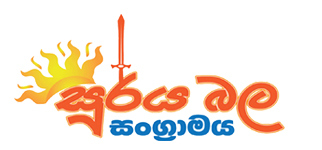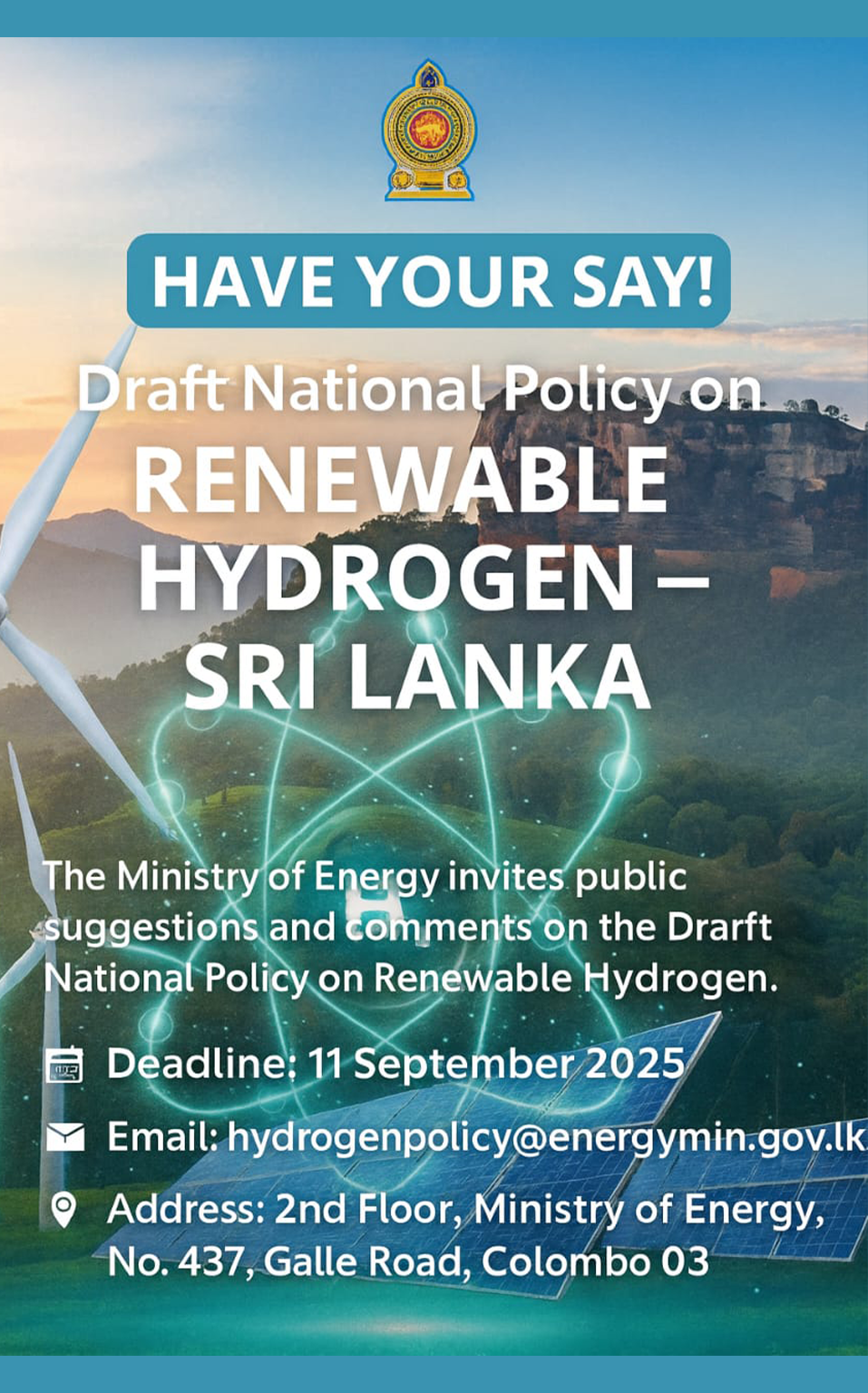Sooriyabala Sangaramaya (Battle for Solar Energy)

The Ministry of Power and State Minister of Solar, Wind and Hydro Power Generation Projects Development has launched a community based power generation project titled 'Soorya Bala Sangramaya' (Battle for Solar Energy) in collaboration with Sri Lanka Sustainable Energy Authority (SLSEA), Ceylon Electricity Board (CEB) and Lanka Electricity Company (Private) Limited (LECO) to promote the setting up of small solar power plants on the rooftops of households, religious places, hotels, commercial establishments and industries. It is expected to add 1000 MW of solar electricity to the national grid by 2025 and 1500 MW by 2030 through this intervention. Under this program, the consumers will have options to generate and use electricity in their premises. In case of electricity generated is more than their requirement, they can sell the excess to the national grid or bank it for later use. According to the electricity usage the customer can select a preferred option from the following three schemes: Net Metering, Net Accounting and Micro Solar Power Producer. The installation service should be obtained by a registered solar service provider.
Net Metering Scheme
Net metering is a billing mechanism that credits solar energy system owners for the electricity they add to the grid.
This means the consumer has to pay only for the net amount of electricity consumed during a month. If the solar electricity supplied to the grid is more than the electricity consumption during a month, the balance amount can be carried forward to future as a credit, up to a maximum of ten years. No payment will be made for the excess electricity supplied over the consumption under this scheme.
Net Accounting Scheme
If the generated units of electricity using the solar panels fixed on houses/premises are greater than the amount consumed, the excess will be paid at the rate of Rs.22.00 per unit during the first 07 years and from the 8th year onwards at the rate of Rs.15.50 per unit by the Utility Provider.
If the consumption is greater than the generated units, the consumer has to pay at the existing electricity tariff for the excess electricity consumed.
Net Plus Scheme
This involves getting paid for the amount of electricity generated using the solar panels fixed on the premises. Unlike the net metering method there is no linkage between the electricity consumption of the customer and the electricity generation. Two separate meters will be installed to measure import and export of electricity separately.
The customer has to pay for the electricity consumed according to the existing tariff whilst the Utility Provider will pay for the total amount of electricity the customer generates.
Solar PV Service Providers
Solar PV service providers (applicant company), having capacity to deliver the complete package of services including survey, design, supply of equipment/materials, installation & commissioning and post installation back up support must register at the Sri Lanka Sustainable Energy Authority to engage in Solar PV Roof Top installation in Sri Lanka. Please refer below for the updated list of registered service providers.
Registered Solar PV service providers may be asked to update and/or provide additional information that may be required for determining the vendor’s ability to participate in specific requests for proposals of major procurements, where additional qualification criteria specific to such projects would be required.
It is mandatory that Solar PV service providers conform to the following;
- Solar PV service providers shall be registered as a company under the Companies Act No 7 of 2007;
- The Solar PV service providers shall be registered as a solar PV service provider at Sri Lanka Sustainable Energy Authority;
- Workers’ Compensation for any accident during the installation/maintenance
Further, it is preferred that:
- Solar PV service providers /Vendor has a technical team with a;
- Minimum of one Graduate Engineer, with minimum of 02 years of industrial experience or Diploma in Electrical/Mechanical Engineering at NVQ 6 level with 05 years of industrial experience of which 01 year in the solar industry; and
- Minimum of 02 Technician, with NVQ 4 or NVQ 3 level or equivalent qualifications and with 02 years of industrial experience.
- Solar PV service providers / Vendors past track record includes;
- A Positive Net Worth.
WARRANTY AND INSURANCE
Warranty
A rooftop PV system has several components and each one of them has its own performance parameters. In order to increase the reliability of the system, the following Minimum warranty and insurance is required for each component:
Solar Module:
- Minimum Manufacturer Warranty for Modules shall cover manufacturing defects for a period of 10 years.
- Minimum performance of 90% of the rated output for first 10 years, and 80% of the rated output for the next 15 years.
- 25-year performance warranty that guarantees a maximum degradation will not exceed 2.5% in the first year, and 0.5–0.7%/yr thereafter.
Inverter:
- Inverter warranty shall cover a minimum of 10 years of manufacturer warranty. This warranty shall cover the defects or damages that may occur to the inverter parts.
Workmanship warranty
- Solar PV system – 5-year workmanship warranty
Mounting and Wiring:
- Warranty cover by the service provider for mounting structure and wiring for 10 years.
Vendors/service providers shall submit necessary test certificates from accredited laboratories and obtain the conformity certificate from Sri Lanka Sustainable Energy Authority for PV panels, inverts and DC Cables as appropriate.
Insurance
The Vendor/Service Provider shall provide 1st year insurance cover for ‘Comprehensive General Liability for the components of the PV system’ through a reputed Insurance Company.
Customer Complaint Procedure
Probable Service-related Issues
- Delays from advance payment to completion
- Actual generation less than projected
- Inadequate response to after sales service issues
- Inadequate support in claiming warranties
steps to be followed in the event of a customer complaint is detailed in the flowchart below.
- All correspondence above should either be by email or letter
- Please refer SLSEA website for contact details of all registered vendors / service providers
- Contact vendors branch
- If no response is received within three days, contact vendors head office
- Still there is no response, contact SLSEA
Rooftop Solar Power Generation Line of Credit (RSPGLoC) Project
The “Rooftop Solar PV Power Generation Project” provides electricity consumers with long-term debt financing for installation of rooftop solar photovoltaic power generation systems in Sri Lanka. The credit line of US $ 50 million established by the Government of Sri Lanka (GoSL) through a loan from the Asian Development Bank (ADB) provides the required financing on preferential terms. As part of the project, technical and commercial frameworks are introduced including technical guidelines and standards for solar rooftop systems that would add value in developing solar rooftop installations. The credit line is managed by the Ministry of Finance (MoF) and funds are channeled to the beneficiaries through selected Banks (Participating Financial Institutions -PFI). The technical support is provided by the Project Implementation Unit (PIU) in close collaboration with MoF, Ministry of Power, Energy and Business Development (MoPE) and Sri Lanka Sustainable Energy Authority (SLSEA).
Power generated through the Rooftop Solar PV Installations can be integrated with the National grid through the Utility Providers in Sri Lanka.
Physical Progress of the project as at 31st December 2021
| Name Of Institute | No. of Loans | Capacity (KW) | ||
|---|---|---|---|---|
| Loan Approved | Loan Disbursement | Loan Approved | Loan Disbursement | |
| CEB | ||||
| Net Accounting | 3,442 | 3,442 | 40,372.035 | 40,372.035 |
| Net Plus | 681 | 681 | 16,417.510 | 16,417.510 |
| Net Metering | 349 | 349 | 3,660.710 | 3,660.710 |
| LECO | ||||
| Net Accounting | 756 | 756 | 7,302.985 | 7,302.985 |
| Net Metering | 158 | 158 | 1,406.220 | 1,406.220 |
| Net Plus | 63 | 63 | 1,765.190 | 1,765.190 |
| Total | 5,449 | 5,449 | 70,924.650 | 70,924.650 |
Category Wise Progress of the project as at 31st December 2021
| No. of Loans | Loan Amount (Rs. Mn) | Capacity (MW) | |
| Commercial | 739 | 2,711.61 | 21.13 |
| Residential | 4,710 | 6,703.64 | 49.80 |
| Total | 5,449 | 9,415.25 | 70.92 |
Solar Workforce Development
As the number of solar installations in the Sri Lanka continues to grow, there is more demand and opportunity for people to join the solar industry, as well as for those already in the industry to expand their knowledge.
Professionals need access to high-quality, local, accessible training in solar energy system design, installation, sales, and inspection, as well as power systems engineering and related professions like building safety officials and first responders. Solar training and energy education play a crucial role in securing the future of solar adoption and achieving the goals of the Sri Lanka. Upon realization of this, SLSEA has conducted and continuing training programmes in the following disciplines. These Training programs include hands-on installation training to develop their skills.
- Trainings for Professionals – Comprehensive training for solar and related professionals
- Solar Technician Training Programs
- Women in Solar Program - This programme is conducted to increase the career opportunities for women in solar industry
